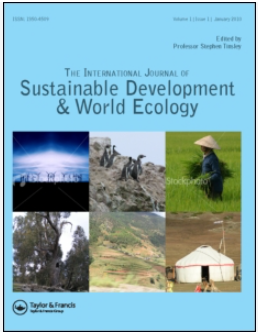生物文化多样性的空间耦合机制——以青海省北川河源国家级自然保护区为例
IF 7.7
3区 环境科学与生态学
Q1 ECOLOGY
International Journal of Sustainable Development and World Ecology
Pub Date : 2023-01-18
DOI:10.1080/13504509.2022.2162148
引用次数: 0
摘要
生物文化多样性是人地关系的重要成果和突出表现。本研究建立了一个超越自然-文化二元论的评价生物文化多样性耦合机制的新框架。以北川河源国家级自然保护区(BRSNNR)为例,结合区域特征,采用耦合协调度模型(CCDM)和典型相关分析(CCA)探讨保护区自然系统与文化系统的关联机制。研究结果表明:BRSNNR具有5类自然文化特征突出的景观特征区;生物多样性与文化多样性空间分布高度重叠,形成“高-中-低”三级生物文化多样性区。分析表明,自然系统和文化系统之间的正反馈或负反馈模式有助于生物文化多样性表征的形成。海拔、动物和交通条件是保护区生物和文化多样性的重要驱动因素。同时,居民的情绪和行为对生物文化多样性的形成有着直接的影响。研究建议,应根据生物文化多样性评价结果划定重点保护区和保护区功能区划,并对约束条件进行阈值计算和设置。该方法有利于提高系统应对风险的能力,形成保护区“因子交互-系统交互-生物文化多样性代表性”的作用机制。本文章由计算机程序翻译,如有差异,请以英文原文为准。
Spatial coupling mechanism of biocultural diversity: case of Beichuan-River-Source National Nature Reserve, Qinghai, China
ABSTRACT Biocultural diversity is an important result and outstanding representation of human-land relationship. This study established a novel framework for evaluating the coupling mechanism of biocultural diversity beyond the nature-culture dualism. Taking the Beichuan-River-Source National Nature Reserve (BRSNNR) as an example, combined with regional characteristics, Coupling Coordination Degree Model (CCDM) and Canonical Correlation Analysis (CCA) were used to explore the correlation mechanism between natural systems and cultural systems in protected areas. The research results indicated that BRSNNR had five types of landscape character areas with outstanding natural and cultural characteristics; the spatial distribution of biodiversity and cultural diversity was highly overlapping, forming a ‘high-medium-low’ three-level biocultural diversity area. Analysis demonstrated that positive or negative feedback patterns between natural and cultural systems contributed to the formation of representations of biocultural diversity. Altitude, animals, and traffic conditions are important drivers for the biological and cultural diversity in protected areas. At the same time, residents’ emotions and behaviors have a direct impact on the formation of biocultural diversity. The research suggests that the priority protection areas and functional divisions of protected areas should be delineated according to the evaluation results of biocultural diversity, and thresholds should be calculated and set for the constraints. This method is conducive to the improvement of the system’s ability to deal with risks and the formation of the action mechanism of ‘factor interaction-system interaction-biocultural diversity representation’ in protected areas.
求助全文
通过发布文献求助,成功后即可免费获取论文全文。
去求助
来源期刊
CiteScore
11.10
自引率
3.60%
发文量
58
审稿时长
18-36 weeks
期刊介绍:
The International Journal of Sustainable Development and World Ecology is now over fifteen years old and has proved to be an exciting forum for understanding and advancing our knowledge and implementation of sustainable development.
Sustainable development is now of primary importance as the key to future use and management of finite world resources. It recognises the need for development opportunities while maintaining a balance between these and the environment. As stated by the UN Bruntland Commission in 1987, sustainable development should "meet the needs of the present generation without compromising the ability of future generations to meet their own needs."

 求助内容:
求助内容: 应助结果提醒方式:
应助结果提醒方式:


